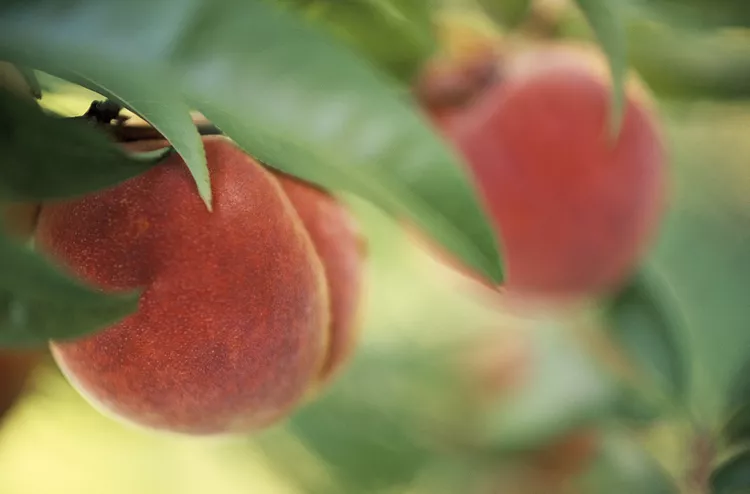Peach Tree Diseases and Pests

Beautiful, fragrant flowers in the spring, followed by sweet, luscious fruit in the summer
—these are just two of the joys of growing a peach tree. These popular stone fruits can be grown in USDA Zones 5 through 8, but they're happiest in the moderate temperatures of Zones 6 and 7.
Plant your peach tree in a sunny spot with loamy, well-drained soil, and keep it well-watered, fertilized, and pruned to encourage the largest harvests.
For the healthiest peach trees, you'll need to start with a cultivar suited to your area's average hours of winter chill. All varieties of peaches require sustained winter temperatures of 45°F or less to stimulate flowering and fruit production in the spring. While most need 500 or more hours of chill, a few varieties do well with as little as 100 chill hours.
However, no matter how well you care for your tree, you'll need to be on the lookout for the many peach tree diseases and pests. These are some of the problems you may face.
Peach Tree Leaf Curl
The most common peach tree disease is a fungus called Taphrina deformans, which causes leaf curl. This frustrating disease stunts the tree's growth and severely hampers fruit production. Unfortunately, it's hard to miss the signs of this fungal infection, which also attacks nectarines. New growth in the spring first turns red, with the leaves thickening and puckering into curls. As the disease progresses, the foliage turns yellow or gray and eventually falls from the tree. Although healthy growth often replaces the fallen diseased leaves, the energy the tree uses to produce the second set of foliage tends to reduce the amount of fruit for the season.
The most effective leaf curl treatment is proactive spraying with a fungicide once the tree drops its leaves in the fall and goes dormant. Depending on where you live, this can be as early as November or as late as January. You'll need to repeat the treatment annually to prevent the reoccurrence of the infection.
You can also significantly reduce the odds of your trees becoming infected with leaf curl by initially choosing varieties resistant to the fungus. Pruning away any infected leaves as soon as you spot them also helps reduce the spread of this common and persistent fungus, but generally, it will return the following spring, especially if conditions remain damp and cool.
Other Fungal Peach Tree Diseases
Peach tree fungus isn't limited to leaf curl. Two other common fungal diseases are:
- Peach scab, caused by Cladosporium carpophilum. This fungal disease, which thrives in warm, humid climates, causes the fruit to crack and rot.
- Brown rot, an infection of Monilinia fructicola, turns peaches from tasty fruit into dried, withered, brown "mummies" clinging to the tree.
You can slow the spread of both conditions by removing diseased foliage, fruit, and twigs at the first sign of infection and spraying the trees with a fungicide once or twice during the growing season.
Life Cycle of a Peach Tree Borer
While many peach tree pests, including leafhoppers, white peach scale, mites, and aphids, none are as big a problem as the peach tree borer. This troublesome insect—its scientific name is Synanthedon exitiosa—is not only fond of peaches, however. It infests other stone fruits, including plums, cherries, apricots, and nectarines.
It's not the adult peach tree borer, which resembles a wasp, that causes all the trouble. It's the creamy-white larvae that wreak havoc in your orchard. After mating in mid to late summer, the female peach tree borer lays her red eggs on the tree's bark. The eggs hatch within a week or two, and the larvae chew their way into the heart of the tree, making use of any existing cracks in the bark and generally staying close to the soil line. The hungry larvae feed inside the tree until winter, which they spend underground on its roots.
At the return of warm weather, the developing larvae feed even more voraciously, causing more damage before transforming into their pupal form in the early summer. The pests emerge as adults around a month later, starting the entire cycle over again.
Signs of Peach Tree Borer Infestation
One of the early signs of a peach tree borer infestation is a reddish, lumpy, sticky mass around the base of the tree trunk. This messy substance is a mixture of sap, sawdust, and frass (insect droppings). You may also spot smaller holes in the lower tree trunk oozing clear sap.
As the insects continue to damage the living tissues beneath the tree bark, it becomes more and more difficult for water and nutrients to travel from the tree's roots to its leaves. Eventually, a heavily infested tree will wilt, lose leaves, or even die. Predictably, fruit production is greatly reduced in these peach trees.
Peach Tree Borer Treatment
The most effective treatment for peach tree borer is insecticide spray applied before the larvae penetrate the tree bark. This means you'll need to spray the lower portion of your peach trees no later than the first week of July and generally once again in early August. Spray heavily infested trees a third time in late August.
Insecticides containing permethrin or carbaryl as the active ingredient generally work very well to kill the larvae and have good residual action to continue killing the pests as they hatch. When spraying peach trees for these insect pests, wet the lower portion of the trunk until the pesticide runs down to the ground. This forces the larvae to crawl through the insecticide as they chew into the bark.
Knowing the signs and treatments for these common peach tree diseases and pests will help you keep your backyard orchard growing healthy and strong.